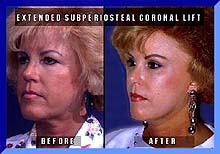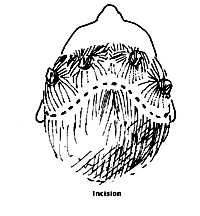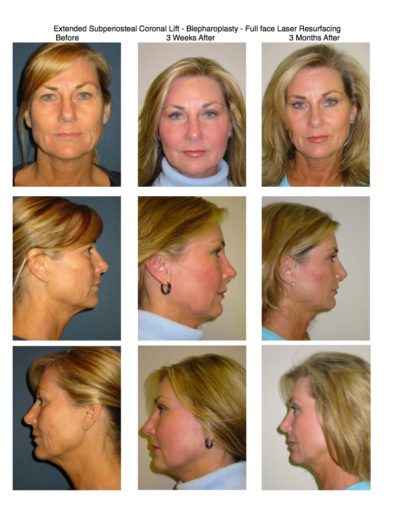 A relatively new innovation in facelift surgery is the extended subperiosteal coronal facelift. This rather complicated term describes a method of facelifting that is based on craniofacial surgical techniques developed in France approximately twenty years ago by world renowned surgeon, Dr. Paul Tessier – noted for his techniques of rebuilding severely deformed children. He described a logical application of these techniques for cosmetic surgery. For over 20 years, we have been carrying out this operation with very gratifying results for selected patients.
A relatively new innovation in facelift surgery is the extended subperiosteal coronal facelift. This rather complicated term describes a method of facelifting that is based on craniofacial surgical techniques developed in France approximately twenty years ago by world renowned surgeon, Dr. Paul Tessier – noted for his techniques of rebuilding severely deformed children. He described a logical application of these techniques for cosmetic surgery. For over 20 years, we have been carrying out this operation with very gratifying results for selected patients.
MORE COMPLETE REJUVENATION
Whereas traditional facelifts are effective in the lower face and neck, this new technique is most effective for the mid and upper face, and permits more complete facial rejuvenation in these areas. While the operation is often carried out alone, it can be combined with other procedures such as necklift, laser resurfacing or with eyelid surgery.
 The operation depends on freeing up of soft tissues from the facial skeleton. Surgery is carried out through an incision made across the top of the head in the hair (the hair is not shaved, or removed). Soft tissue and muscle are completely separated from bone around the orbit, the cheekbones and the forehead. The tissues are then lifted as a complete unit effectively reversing the gravitational changes of aging.
The operation depends on freeing up of soft tissues from the facial skeleton. Surgery is carried out through an incision made across the top of the head in the hair (the hair is not shaved, or removed). Soft tissue and muscle are completely separated from bone around the orbit, the cheekbones and the forehead. The tissues are then lifted as a complete unit effectively reversing the gravitational changes of aging.
As with all surgery, the operation is not without some risk. The plane of dissection is close to the nerves that control movement of the face. Surgeons who undertake this work are wise to spend time in the anatomy lab before operating on patients. Still, according to Dr. Howard Tobin, who has taught the operation to surgeons from throughout the world, results are superior to anything available before now. Doctors from all over have come to the Facial Plastic and Cosmetic Surgical Center to study these techniques.
RECOVERY SIMILAR TO STANDARD LIFT
While the operation is admittedly more complex than traditional facelift surgery, once the technique is mastered, it is as safe as conventional techniques. Most patients resume relatively normal full activity within one to two weeks – not much different than with less extensive techniques.
OPERATION COUNTERS THE EFFECTS OF GRAVITY
What’s really exciting about the operation is that it allows correction of areas that saw little improvement with older, more traditional procedures. As we age, gravity takes its toll. Not only is there laxity of the skin with wrinkling and crepiness, there is also a drooping of the brow, the corner of the eyes and the corner of the mouth. Folds between
the nose and cheek get deeper and slack tissue hangs over the corner of the jaw. Traditional facelift surgery attempts to correct these changes by pulling the skin, subcutaneous tissue, and perhaps the muscles of the neck, backward toward the ear. While this results in tightening, it does not counter the downward pull of gravity.
 PULL IS IN THE RIGHT DIRECTION
PULL IS IN THE RIGHT DIRECTION
While the traditional or endoscopic coronal lift does pull in the right direction, its effect is limited to the forehead and brow. The extended subperiosteal coronal lift builds upon the advantage of the upward pull provided by the coronal lift. It allows a general lifting of all of the structures of the face from the forehead down to the lower jaw. It is
particularly effective in enhancing the cheekbone area. The operation is carried out under general anesthesia and takes about the same time as a conventional facelift. Operating times vary according to patient needs but usually last about three hours.
Starting through a tiny incision in the mouth, the tissues and muscles are first lifted from the cheekbones up to the orbit. The incision is then made across the top of the head, well within the hair. The soft tissues and muscles of the face and forehead are carefully lifted off of the bone. Laser assisted surgery allows greater precision and helps to minimize bleeding and postoperative swelling.
ALL AREAS COVERED
These structures are then pulled upward and attached to the firm dense tissues of the scalp and to underlying bone. Sometimes, the operation is combined with necklifting and eyelid surgery resulting in a total facial rejuvenating procedure. Following the operation, there may be moderate swelling or bruising, although, this varies a great deal. In a few cases, tissue stretching has led to weakness in the muscles that arch the forehead for a period of several months, although normal function has ultimately returned in most cases. Numbness is often present for a while after surgery but again, this is usually short-lived. While there are other complications that can occur, the extended operation has proven as safe as conventional facelift surgery.
RESULTS ARE BETTER
When it comes to results, there is a decided difference. The new technique not only provides a stronger lift, it allows a more balanced improvement. Because the lift is not just related to skin stretching, the results seem far longer lasting. The enthusiasm of surgeons who have learned this technique is largely due to the satisfaction of patients who have had the surgery. At our Center, it is fair to say that patients have never been happier with the results of facial rejuvenation surgery than with the extended subperiosteal coronal lift. Dr. Tobin has described his experiences with the extended subperiosteal coronal lift in textbooks as well as in an article published in the American Journal of Cosmetic Surgery. Reprints of these articles are available on request.

